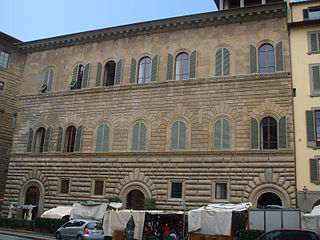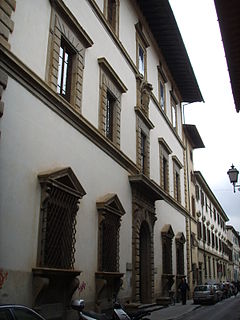
Palazzo Rucellai is a palatial fifteenth-century townhouse on the Via della Vigna Nuova in Florence, Italy. The Rucellai Palace is believed by most scholars to have been designed for Giovanni di Paolo Rucellai by Leon Battista Alberti between 1446 and 1451 and executed, at least in part, by Bernardo Rossellino. Its splendid facade was one of the first to proclaim the new ideas of Renaissance architecture based on the use of pilasters and entablatures in proportional relationship to each other. The Rucellai Palace demonstrates the impact of the antique revival but does so in a manner which is full of Renaissance originality.

Piazza della Signoria is an L-shaped square in front of the Palazzo Vecchio in Florence, Italy. It was named after the Palazzo della Signoria, also called Palazzo Vecchio. It is the main point of the origin and history of the Florentine Republic and still maintains its reputation as the political focus of the city. It is the meeting place of Florentines as well as the numerous tourists, located near Palazzo Vecchio and Piazza del Duomo and gateway to Uffizi Gallery.

The Palazzo Medici, also called the Palazzo Medici Riccardi after the later family that acquired and expanded it, is a Renaissance palace located in Florence, Italy. It is the seat of the Metropolitan City of Florence and a museum.

The Knights’ Square is a landmark in Pisa, Italy, and the second main square of the city. This square was the political centre in medieval Pisa. After the middle of 16th century the square became the headquarters of the Order of the Knights of St. Stephen. Now it is a centre of education, being the main house of the Scuola Normale di Pisa, a higher learning institution part of the University.

Palazzo della Carovana is a palace in Knights' Square, Pisa, Italy, presently housing the main building of the Scuola Normale Superiore di Pisa.

The Vasari Corridor is an elevated enclosed passageway in Florence, central Italy, which connects the Palazzo Vecchio with the Palazzo Pitti. Beginning on the south side of the Palazzo Vecchio, it then joins the Uffizi Gallery and leaves on its south side, crossing the Lungarno dei Archibusieri and then following the north bank of the River Arno until it crosses the river at Ponte Vecchio. At the time of construction, the corridor had to be built around the Torre dei Mannelli, using brackets, because the owners of the tower refused to alter it. The corridor covers up part of the façade of the Church of Santa Felicita. The corridor then snakes its way over rows of houses in the Oltrarno district, becoming narrower, to finally join the Palazzo Pitti. It was closed in 2016 for safety reasons. In 2019, the Uffizi Gallery announced that the corridor will re-open for tourists in 2021.

San Nicola is a church in Pisa, Tuscany, Italy.

The Palazzo delle Vedove is a palace in Pisa, Tuscany, Italy.

Santa Caterina d'Alessandria is a Gothic-style, Roman Catholic church in Pisa, region of Tuscany, Italy.

The statue of Cosimo I de' Medici stands in the middle of Knights' Square of Pisa, just in front of Palazzo della Carovana.

The Palazzo Chigi-Saracini is a Gothic urban palace on the Via di Città in the Terzo di Città in central Siena, Tuscany, Italy. In 2014 it housed the Accademia Musicale Chigiana.

Palazzo Gondi is a palace in Florence, Italy, located a block from Piazza della Signoria. It was built in 1490 under design by Giuliano da Sangallo, who was inspired by other major works of stately buildings in the city, such as Palazzo Medici and Palazzo Strozzi. Among the elements borrowed from these earlier works are the cube-shape set around a central courtyard, the ashlar sloping on each of three floors, and the arched windows.

The Palazzo del Capitano del Popolo or Palazzo di Cante Gabrielli is a medieval palace in Gubbio, Italy. It is located in the San Martino's quartiere, near Porta Metauro, at the corner of via Gabrielli and via Capitano del Popolo.

The Palazzo Spannocchi is a Renaissance style urban palace located on the Piazza Salimbeni, just off Via Banchi di Sopra in the Terzo di Camollia of the city of Siena, region of Tuscany, Italy. The building was associated with an ancient mercantile family of Siena.

Palazzo Sansedoni is a Gothic style urban palace and tower, whose concave facade is situated facing the Palazzo Pubblico across the Piazza del Campo in the political center of the city of Siena, region of Tuscany, Italy.

Palazzo Cesi-Armellini, sometimes known plainly as Palazzo Cesi, is a late Renaissance building in Rome, important for historical and architectural reasons. The palace, which should not be confounded with Palazzo Cesi-Gaddi, Palazzo Muti-Cesi, or the destroyed Palazzo Cesi, placed also in Borgo near the southern Colonnade of St. Peter's square, is one of the few Renaissance buildings of the rione Borgo to have outlived the destruction of the central part of the neighborhood due to the building of Via della Conciliazione, the grand avenue leading to St. Peter's Basilica.

The Palazzo Giugni, also called the Palazzo Firenzuola, is a late-Renaissance or Mannerist architecture palace designed by Bartolomeo Ammanati, and located on Via degli Alfani #48 in the quartiere San Giovanni of Florence, region of Tuscany, Italy. It is located down the street from the Brunelleschi's church of Santa Maria degli Angeli.

The Palazzo Lanfranchi-Toscanelli, presently the local State Archives, is a Renaissance-style palace located on Lungarno Mediceo #30, in the city of Pisa, region of Tuscany, Italy. Since 1913 the building has housed the Archivio di Stato di Pisa.
The Palazzo Lanfranchi is a palace located on Lungarno Galileo Galilei #8, in the city of Pisa, region of Tuscany, Italy.

The Palazzo degli Anziani also known as the Palazzo del Comune, della Comunitá or del Giano is a Gothic-style stone palace located in the ancient historic center of Pistoia, Tuscany, Italy. The palace served as city hall for centuries; it still belongs to the comune and now mainly houses the Museo Civico d'Arte Antica.

























